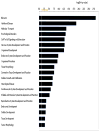Ingestion-controlling network: what's language got to do with it?
- PMID: 20458888
- PMCID: PMC3263760
- DOI: 10.1515/revneuro.2010.21.1.67
Ingestion-controlling network: what's language got to do with it?
Abstract
The prevalence of obesity has increased dramatically worldwide, whereas the types of treatment and their efficacy have not substantially changed over the last two decades. Additionally, drugs used to control weight gain could occasionally create untoward effects in cardiovascular functions, as well as in behaviors, memory, sleep, and emotions because the molecular machinery responsible for ingestion control is interconnected with or shared by the above domains. How each group of drugs preserves the privacy of its message in the mutual network is not fully understood. In the present essay, the graph theory approach was used to explore some aspects of molecular signaling as though they were a 'language'. Its emphasis is on 'molecular polysemy', a term that refers to the ability of biomolecules to be used like words in natural languages more than one-way. This has physiological and clinical implications, in particular when planning drug designs with "specially engineered shotgun loads" that target a combination of biomolecules that assure a better therapeutic outcome without causing deficits in connected but patho-physiologically irrelevant bystanders.
Figures





Similar articles
-
Folic acid supplementation and malaria susceptibility and severity among people taking antifolate antimalarial drugs in endemic areas.Cochrane Database Syst Rev. 2022 Feb 1;2(2022):CD014217. doi: 10.1002/14651858.CD014217. Cochrane Database Syst Rev. 2022. PMID: 36321557 Free PMC article.
-
From computing with numbers to computing with words. From manipulation of measurements to manipulation of perceptions.Ann N Y Acad Sci. 2001 Apr;929:221-52. Ann N Y Acad Sci. 2001. PMID: 11357866 Review.
-
Message-adjusted network (MAN) hypothesis in gastro-entero-pancreatic (GEP) endocrine system.Med Hypotheses. 2007;69(3):571-4. doi: 10.1016/j.mehy.2007.01.048. Epub 2007 Mar 23. Med Hypotheses. 2007. PMID: 17363176
-
Rule-based modeling of signal transduction: a primer.Methods Mol Biol. 2012;880:139-218. doi: 10.1007/978-1-61779-833-7_9. Methods Mol Biol. 2012. PMID: 23361986 Review.
-
Multitasking of neuropeptide Y through the lens of motifs.Recent Pat CNS Drug Discov. 2009 Jan;4(1):52-60. doi: 10.2174/157488909787002591. Recent Pat CNS Drug Discov. 2009. PMID: 19149714 Review.
Cited by
-
The 'Tyranny of choices' in the ingestion-controlling network.Obes Facts. 2009;2(6):374-82. doi: 10.1159/000260906. Epub 2009 Dec 4. Obes Facts. 2009. PMID: 20090389 Free PMC article.
-
Winning a won game: caffeine panacea for obesity syndemic.Curr Neuropharmacol. 2010 Jun;8(2):149-60. doi: 10.2174/157015910791233213. Curr Neuropharmacol. 2010. PMID: 21119886 Free PMC article.
References
-
- Myslobodsky M. Molecular Network of Obesity: What does it Promise for Pharmacotherapy? Obesity Rev. 2007;9:236–245. - PubMed
-
- Kishi T, Elmquist JK. Body weight is regulated by the brain: a link between feeding and emotion. Mol Psychiatry. 2005;10(2):132–146. - PubMed
-
- Berthoud HR. Homeostatic and non-homeostatic pathways involved in the control of food intake and energy balance. Obesity (Silver Spring) 2006;14(Suppl 5):197S–200S. - PubMed
-
- Yildirim MA, Goh KI, Cusick ME, Barabasi AL, Vidal M. Drug-target network. Nat Biotechnol. 2007;25(10):1119–1126. - PubMed
Publication types
MeSH terms
Substances
Grants and funding
LinkOut - more resources
Full Text Sources
